The first mention of a nursing library dates back to 1890 when the Adelaide Hospital Board approved a recommendation to establish one. This was funded by nurses’ lecture fees paid to the hospital. Later, the unclaimed ‘bond money’ that nurses paid to the hospital for board and training was also used to purchase books. The Nurses Library was then located in the Nurses Home [later renamed Margaret Graham Building].


First Purpose Built Library – 1954-1968
The year 1954 saw the opening of the first purpose-built nursing training facility, located in the basement of the new nurses home [later called the Eleanor Harrald Nurses Home]. The Nursing Tutors were responsible for managing a small nursing library, but the hospital did not allocate much funding to it. By 1955 the school subscribed to three periodicals – the Nursing Times, the Nursing Mirror and the Australian Nurses Journal – but the number of reference books remained small, estimated between 100 and 200 books.
The original library also served as a classroom for demonstrations. To borrow a book, student nurses manually entered their names, the date, and the book they wished to borrow on cards.
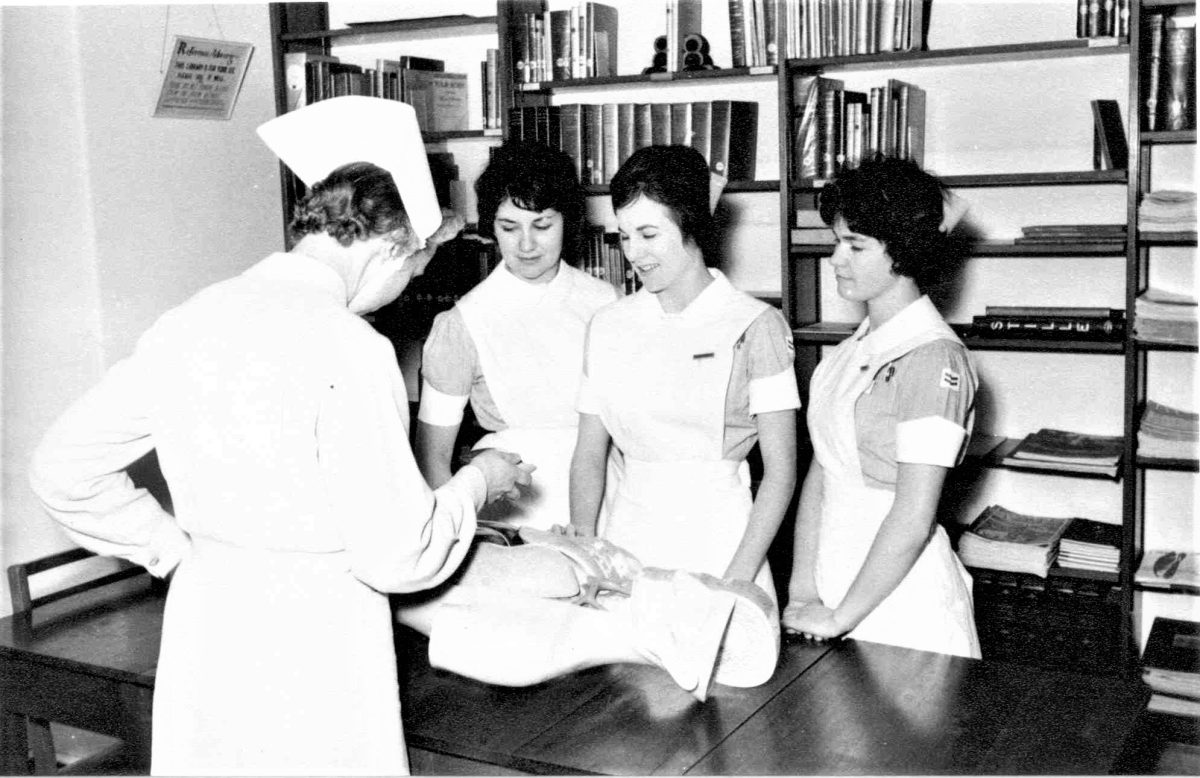
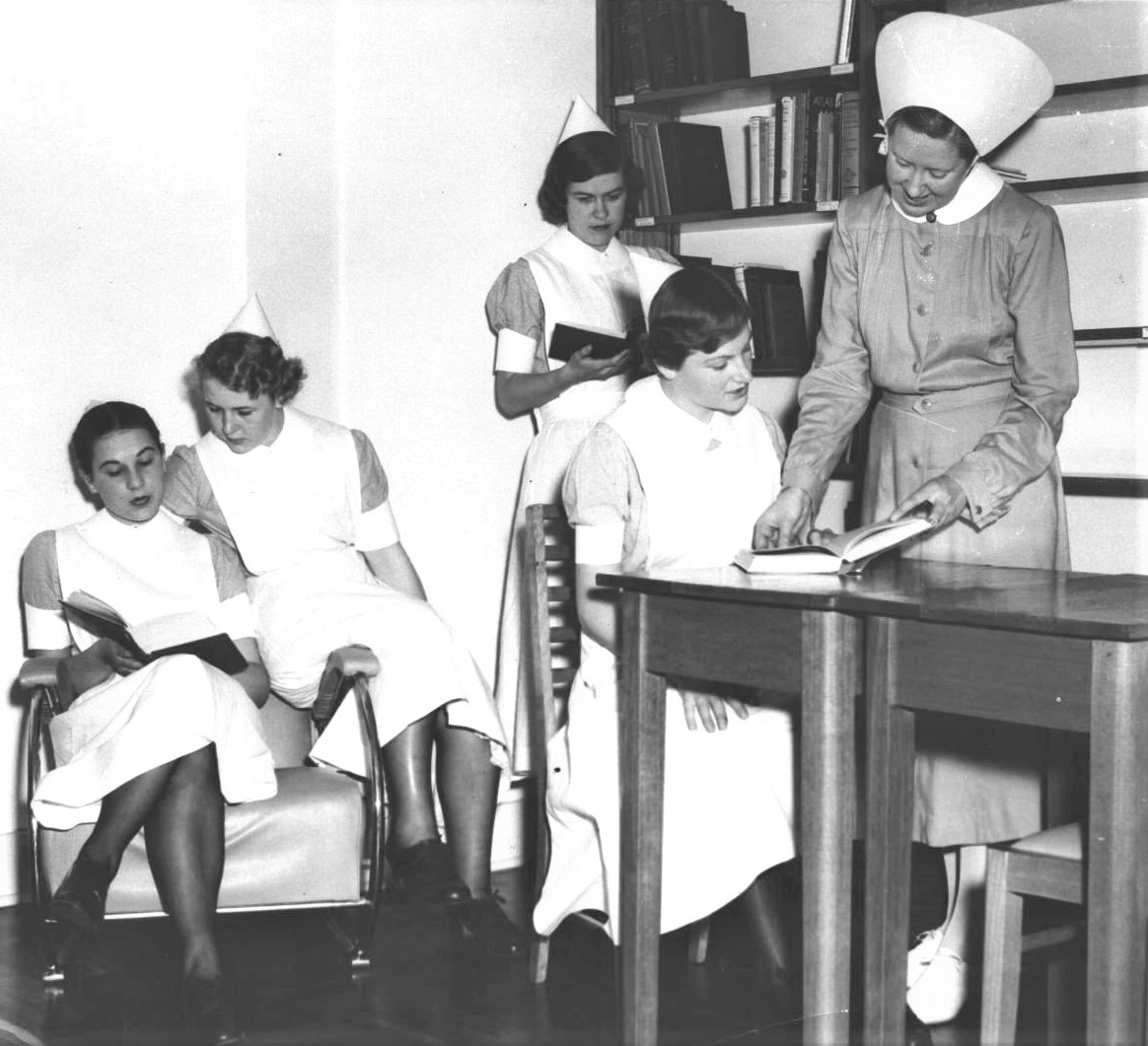
Lack of available funds for book purchases was a recuring theme. In the hospital board minutes, 13 May 1968, “a recommendation was received for the purchase of reference books at an estimated cost of $60 for the Nurses Library from the Commissioners of Charitable Funds.” In comparison, two weeks later, the Commissioners of Charitable Funds agreed to allocate $1,500 available for books for the doctor’s Medical Library.
Relocation of Nurses Library
The School of Nursing underwent a significant transformation in late 1968, moving to the Whitford Building, corner of North Terrace and Frome Road, which would later be known as the Women’s Health Building.
The library was located on the ground floor, which provided a significantly larger space. A small committee of nursing tutors was formed to assist in maintaining and developing the library. Additionally, two nurse attendants were employed, and part of their activities were to assist with the library’s operations. In 1973, the library changed from a simple alphabetical system to the Dewey classification system.
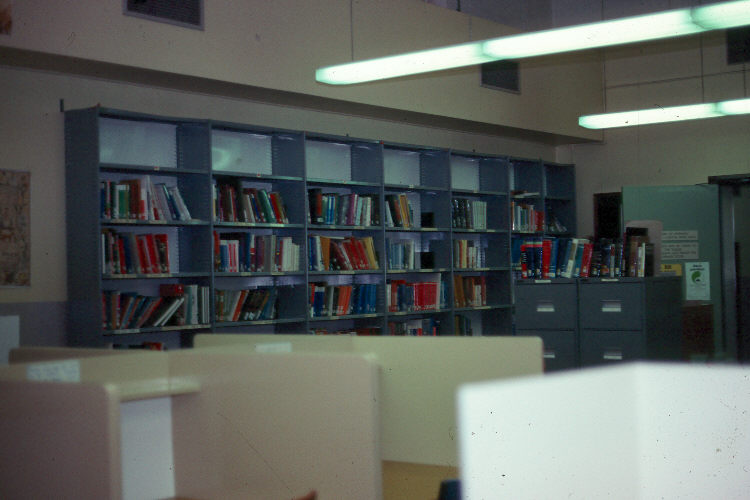

Physical Description of Library
The library was rectangular in shape and comparable to an attic due to its sloping roof, with two rows of windows. The ceiling was high, and the reading area was illuminated by three long fluorescent lights covering the width. It was carpeted, air-conditioned, and had a total of six air vents, along with three radiators.
The entrance was located via North Terrace. The circulation desk was to the left of the entrance, and on the right side was a photocopying machine. The photocopier was not purchased until 1971. Behind the photocopier was a pin-up board explaining library procedures and opening times. Adjustable shelving space was located on three of the walls and made of grey metal. The fiction collection was located on the shelves nearest to the circulation desk, and further down were the periodicals.
In the central area, tables and chairs took up three-quarters of the space. There were seven large tables, each with five chairs, as well as two desks pushed together with two chairs forming a smaller table. The circulation desk had the catalogue for reference and fiction books, and nearby, there were racks holding periodicals, pamphlets, and journals.
The librarian’s office was located opposite the North Terrace entrance, to the left. In addition to a desk used by the librarian, the office held the work area for the full-time clerk who was employed to stencil teaching materials needed for students by tutors. There was also a long work table for general use. At the back of the room, there were overfull cupboards and books designated as the stack area. This room and entrance were restricted, and no students were allowed.
For many years, there was only one phone in the Library, which could only receive internal calls. Staff were unable to make outgoing calls.
Professional Librarian
In 1976, the hospital recognized the need for a knowledgeable librarian to manage its growing collection of nursing books and support the education of around 650 nursing students. For two months in 1976, Wietski (Vicki) Ledo was employed at the School of Nursing Librarian. During her time she wrote a report on the basic procedures for running the library, which she established before her departure. Then, on 17 February 1977, Mary Peterson (nee Jones) was appointed as the ongoing Nursing Librarian. At the time, the hospital did not have librarians on its payroll, instead they were seconded from the State Library. Mary became an employee of the Royal Adelaide Hospital in 1979, where she reported to the Chief Medical Officer.
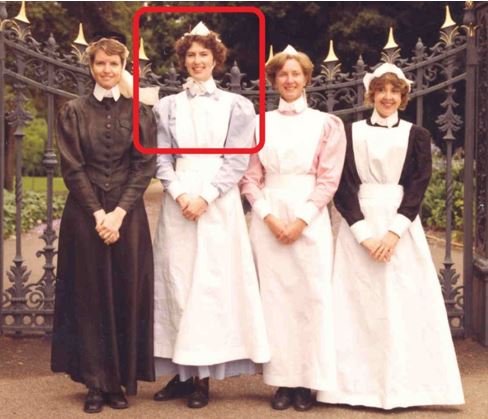
Mary, as the Nursing Librarian, took part in Medical Library Committee meetings and established monthly Nursing Library Committee meetings. This was led by the Deputy Principal Nurse Educator primarily to assess procurement decisions. Initially, Mary was in charge of all Government School of Nursing Libraries in the Northern Areas, including the Royal Adelaide Hospital, Northfield, and Modbury, as well as the Dental Library at the Adelaide Dental School:
This mainly involved cataloguing for the Government Hospitals and Dental School. At the Nursing Library at Modbury, cataloguing was performed on a basic level without analytics or tracings, and only needed to be checked by the RAH School of Nursing Librarian
EB Naumczyk, A Case Study of Two School of Nursing Llibraries, 1977
This arrangement did not last long, and Mary became solely responsible for the RAH School of Nursing Library.
Nursing Librarian Duties:
- Selecting, purchasing and cataloguing books;
- Executing inter-library loans;
- Providing current information to nurse educators and sister tutors;
- Offering reference assistance and conducting literature searches for all users; and
- Managing Government Hospital Libraries in the Northern Areas.
Library Users
The School of Nursing’s library was designed to be used by all nursing staff at the Royal Adelaide Hospital. It held materials related to various training and refresher courses offered by the School, such as a three-year general student course leading to state nursing registration; a one-year trainee enrolled nurses course; post graduate courses covering various subjects; and three-month refresher sister courses for sisters re-entering the workforce.
Around 2000 nurses were eligible to use the library in 1977, as indicated in the statistical leaflet released by the Nurses Board of SA in December 1976. This showed staff/student ratios and the percentages of qualified staff in most SA Nursing Schools. According to the leaflet, the Royal Adelaide Hospital School of Nursing had 39 full-time and 4 part-time staff with a total of 1,350 students, 10% of whom were male (not including all the nursing staff employed at Royal Adelaide Hospital who were also entitled to use the Library).

Library Attendants
Until the appointment of the library’s first librarian, the library had been managed by library attendants, who occasionally sought advice from the hospital’s medical librarian regarding cataloguing issues. During occasional absences of the attendant, a clerk responsible for stencil work for nurse educators would take over the circulation desk. During annual leave, one of the nurse educators would be in charge of the library.
Library Attendant Duties:
- Manage circulation, including filing and knowledge of Dewey Decimal Classification system for shelving arrangement
- Maintain card catalogue filing system.
- Manage accounts, fines, and general bookkeeping. Also, served as a cashier at the circulation desk.
- Handle technical services such as book processing.
- Perform typing tasks related to the library, including managing stationery and correspondence. Type catalogue cards onto stencils.
- Print stencils for library catalogue cards.
- Respond to general reference queries, including subject and catalogue inquiries.
Opening Hours
The library was open every day from 8:30 am to 5 pm, with the exception of the weekends when it remained closed. The primary reason for not extending the library’s hours to the evening was the need for access to the entire building after hours, which would necessitate having porters available to lock and unlock doors. The library’s facilities and services, such as book borrowing and book returns, also required the presence of an attendant.
In February 1977, a book return chute was installed, allowing book returns until 10 pm when the building closed. For a trial period, the library extended its hours until 9 pm under the supervision of a nurse educator. However, this was discontinued due to low student usage.
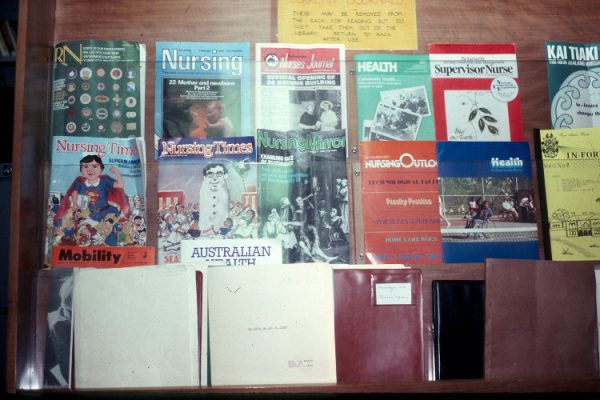
Australian Red Cross Society
In 1947, The Matron advised the Hospital Board that the:
Australian Red Cross Society had generously donated and installed a fiction and reference library for the nurses of 327 books. Red Cross librarians began servicing the library on 12 March and would be in attendance to issue books three times a week. One penny per fortnight would be collected on each book obtained, and from this small revenue, it was hoped to give the Red Cross a donation towards repairing and keeping the library up to date.
Royal Adelaide Hospital Board Minutes, 19 March 1947
This arrangement persisted for several decades, with the Australian Red Cross regularly sending batches of books to supplement the fiction collection. As nurses started living off-site, this practice was phased out.
Fiction Section
The collection included a variety of easy-reading material encompassing genres like romance, biographies, art, sports, history, travel and geography. The fiction section spans across of 21 shelves.
The Fiction Key system used coloured dots to categorize different types of books:
- Blue – romance, adventure, historical
- Green – detective
- Brown – westerns
- White – general, travel, humour.
Margaret Graham Collection
The Margaret Graham Collection was one of the collections held in the Nursing Library. It was kept on separate shelves and mainly included material related to nursing research, administration, and management. With financial assistance from the Nurses’ Education Fund, this collection remained up-to-date and relevant to the needs of the nursing staff. However, when the Medical and Nursing Libraries merged, the Nurses’ Education Fund discontinued funding for the purchase of library books for the Margaret Graham Collection. As a result, the books in the collection were amalgamated with the rest of the books, but they still retained the bookplate that indicated their original funding source. Over time, most of the books in the collection were replaced with newer editions.
Budget
The Nursing Library had its own budget for obtaining resources and worked together with the Medical Library to avoid duplication in the collections. In 1976, approximately $2500 was spent by the RAH School of Nursing. There was a separate budget for models and AV equipment/material. Approval from the Director of Nursing for book purchases was not necessary as long as they were within budget. However, requests for models and AV equipment/material did require approval from the Director of Nursing. Despite the increasing number of students, inflation, the addition of post-basic courses, and the need to keep up with modern requirements, the budget remained relatively static.
Book Selection
By 1977, the library’s collection had grown to approximately 6,000 books. The selection of periodicals and books was determined by the Library Committee, with the approval of the Principal Nurse Educator. The selection policy stated:
- Prioritise cheaper books;
- Books that will get plenty of use;
- Books that are not too ‘highbrow’;
- Avoid expensive books for those subjects not in constant use; and
- Ensure duplicate and multiple copies are only purchased for those subjects in demand.
Once the books were chosen, the order was submitted to the Supply Department. The librarian also had a petty cash float of $300 a year, which allowed her to buy books on sight without going through the Supply Department.
There was also an inter-library loan service, allowing borrowers to access books from the Sturt College of Advanced Education, The Queen Victoria Hospital, as well as the Barr Smith Library. Additionally, students were permitted to borrow past examination papers for studying purposes.
Borrowing / Membership
To become a member of the library, a twenty-five cent membership fee was required for individuals studying or working at the Royal Adelaide Hospital. Once a member, individuals could borrow books for the duration of their time at the hospital. The standard book loan period was one week, but it could be extended to two weeks if needed. Nurse Educators had extra borrowing privileges, allowing them to borrow books and journals indefinitely.
When borrowing a book, the borrower’s name, group number, and ward were recorded on a book card. Both the book card and the date slip were stamped with the due date. Fiction and reference book cards were filed separately, with fiction cards organized alphabetically by author. Upon returning the books, the due date was checked for fines and then crossed out, making the books ready for reshelving.
For overdue books, notices were sent after 2 weeks. A fine of twenty-five cents per hour was charged for every hour the book was overdue. If there was no response to the notice, an account covering the cost of the book was sent.

Media Resource Centre
In 1976, the Royal Adelaide Hospital School of Nursing Media Resource Centre was established with Irene Cuffe appointed as the full-time Audio-Visual Officer. Her responsibilities included creating transparencies, copying slides, instructing nurse educators and users on media use, recording programs onto video cassettes, setting up films for lectures, and maintaining the equipment.
The Media Resource Centre was equipped with various audio-visual tools such as audio and video cassettes, slides, film, television, and video recorders. Additionally, it housed anatomic models, medical training equipment (e.g., skin traction kits, walking sticks, Thomas splints), posters, charts, and diagrams. The resources were available not only for nursing staff and students but also for the entire hospital staff and the Dental School. Student access was limited to certain materials like slides, slide projectors, transparencies, charts, specimens, and models.
Staff Development
As nursing education transitioned towards universities, the Nursing Library’s role in staff development grew significantly. A small library was established at Hampstead Rehabilitation Centre to support nursing education and cater to the needs of nursing and allied health staff. To enhance its resources, materials were transferred from the North Terrace campus through the Royal Adelaide Hospital courier service, further strengthening its role in staff development.
As the role of the School of Nursing Library evolved, its location was considered less than ideal. The library started to be used more frequently by nursing staff from ward areas, which emphasized its isolated position on the hospital site. Moreover, the library’s operating hours (8:30 am to 4:45 pm, Monday to Friday) were not convenient for nursing staff working 24-hour shifts.
In 1999, the Nursing Library was merged with the Royal Adelaide Hospital and Institute of Medical and Veterinery Science libraries to form a single clinical library service.
Written by Margot Way, CALHN Health Museum
(Information sourced from Trove, Ancestry, and SA Health Museum collection. Copies of all newspaper articles and other relevant documents are available on request).